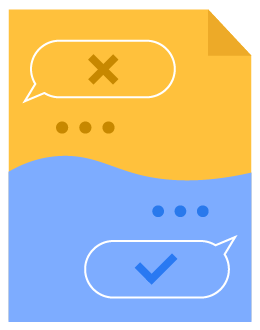Cold Calling Objections and Responses for B2B Appointment Setting


Brent Walrath
This post was originally published in November 2019 and has been updated for accuracy and comprehensiveness.
Cold-calling objections and rebuttals differ greatly from the objections a salesperson might encounter when closing. Where the goal of closing is obviously to convince a prospect to buy, the goal of a cold call is to determine whether your company’s solution is a good fit for the prospect and to present it in a way that encourages them to learn more about the unique value of your offering.
Some salespeople may initially struggle with fielding objections but, with time and experience, a good sales development rep (SDR) will hone in on a prospect’s objections and use them as an opportunity to find out more about their prospect, address their pain points and ease their uncertainties, and reiterate the clear benefits of their solution.
Your SDRs will almost certainly encounter the common appointment-setting objections we’ve included in this post at some point – it’s just a matter of time. To increase their chances for success, it’s imperative that they have the necessary tools to navigate these common objections with confidence. If setting more sales meetings is your goal, you need to have a deep understanding of these common objections and know the best rebuttal suited for the situation.
Below, we’ve outlined some of the most common objections our SDRs have encountered and the best responses they use to ignite curiosity in their prospects and drive the conversation forward.

Download the Cold Calling Objections Cheat Sheet
Download the cheat sheet to equip your SDR team with expert responses to common cold calling objections.
How to handle common cold-calling objections
1. “I’m the wrong person to talk to.”
Think of this objection as less of an obstacle and more of an opportunity to get a referral to reach the right person. Use the wrong contact as a springboard to finding the right contact.
“Maybe you can help me out. Can you refer me to the person I should speak with?”
If you’re unable to get a referral or the individual you’re speaking to isn’t sure of an appropriate name to give you, try to establish some kind of direction that you can use to facilitate forward momentum on your next attempt. At the very least, your contact likely has insight into which particular business unit oversees the processes that your solution supports.
“Which department or team would it make the most sense for me to contact?”
If all else fails and you can’t make any progress with the contact and aren’t referred to anyone else, just do your best to leave a good impression on the call. Even if it’s become abundantly clear that this person will never buy your product or have any meaningful say in their company’s potential purchase of your solution, you never know what kind of conversations are going on within their company or how far their word-of-mouth travels.
“Would it be appropriate if I sent you some information about our company for you to pass along to the correct folks?”
Here too – the prospect may say no; they may say yes only to not pass the information along, leaving it to collect dust and be forgotten about. What’s certain is that that information will never get into the right hands if you don’t ask the question.
2. “I’m too busy right now.”
Typically when prospects use this objection, what they’re really implying is, “My time is valuable, and it would be better spent elsewhere.” In these situations, it’s crucial for an SDR to prove that your solution is at least as valuable as their limited time, and do so as quickly as possible.
The first approach in countering this objection is to dive deeper into prospect discovery to uncover exactly how much value your offering could provide.
“What projects are you currently working on?”
It’s just a fact, B2B buyers allocate the most time to matters that they believe will give them the highest return. As such, your SDRs should be thinking strategically about the new discovery information they glean from the prospect, and use it to devise a compelling way to show the prospect how your solution could help solve any business challenges or pain points you uncover. Additionally, using concrete numbers may not always be possible, but it certainly goes a long way. It’s always easier for people to both demonstrate and understand value through data. Just look at this example:
Prospect: “We’re in the middle of a big retention initiative. We’re aiming to renew over 200 of our largest customer accounts but we only have 2 months to do it.”
SDR: “Sounds like an ambitious project with a tight deadline! If you’re interested, I can give you some info on how EBQ has helped clients retain over 80% of their customers with direct outbound efforts.”
Providing real numbers serves to make the value of your solution more tangible to your prospect. That said, you should always be considerate and recognize when a particular objection should be taken at face value. The next time you find yourself in a situation where you catch your prospect at a bad time, here are some polite alternate responses:
“Is there a better time for me to call back and discuss this subject?”
“Would it be alright if I sent you information on our company to keep in your files, in the event the need to chat comes up in the future?”
3. “I’m not interested.”
This objection is almost always used as a knee-jerk reaction that happens once a prospect realizes they’ve answered a sales call. They may say they’re not interested but remember – this person is on your contact list for a reason. You’ve already determined that they match the profile of buyers who are interested in your offering.
Knowing this, steer the conversation away from selling your solution and drive it towards learning about what buyers in your prospect’s position care about most – make them the focus.
“I understand. I’m curious to know, though, what could I have said about this topic that might have actually interested you?”
With any luck, the information they provide could potentially help steer the conversation in a direction they consider more interesting and engaging. At best, you get the prospect interested and begin to create forward momentum. At worst, you get some solid feedback for your opening value statement.
4. “Is this a sales call?”
If you’re not careful, this question can quickly lead to the most dreaded objection of them all: “I’m not interested”. Luckily, you’re not calling to make a sale and you should make this clear on the call. As an SDR, you’re calling to inform them about a product or service that could improve their day-to-day life, then offering an opportunity to learn more about it.
As stated before, the key thing to remember is that your response should reassure them that there won’t be any sales attempt coming from you. You’re simply trying to help them understand how they would benefit from your solution. The first step is to confirm that they are in fact one of the people in their organization who would benefit.
“I am not in a sales capacity at [company name]. I actually support our marketing efforts here and am calling to see if [area of expertise] is something you’re tasked with overseeing.”
You can also leverage past attempts to contact them to nurture a sense of familiarity and helpfulness that they then associate with how you and your company conduct business.
“I’m following up on an email I sent your way to see if [area of expertise] is an area that you or your team deals with. Do you have 60 seconds to learn a bit about our company, and how our customers benefit from our partnership to see if it makes sense to speak again at some point in the future?”

Subscribe to EBQ's Bimonthly Newsletter

Subscribe to EBQ's Bimonthly Newsletter
5. "Just send me some information.”
It’s difficult to determine whether this objection is good or bad at first glance—it always requires proper discovery. Your contact could be employing this objection purely as a way to end the call in a hurry, but at least they’ve appeared to open themselves up to learning more.
That said, it’s always better to give your prospect the details while they’re still on the line so you can gauge their interest more accurately. Be respectful of their time and let them know you’ll make it quick.
“Do you have just 60 seconds right now for me to explain what we do and how our customers benefit from a relationship with [company name], and then you can decide if it’s worth a follow-up?”
If you’ve already explained the offering and they ask for additional info, pitch them the sales meeting:
“Typically, we find people get more value from a short conference call or solution demonstration to learn about who we are and how you can benefit from working with us.”
Alternate responses like the ones below serve to help you gather more discovery information and qualify the contact:
“I have tons of information I can send your way, but I don’t want to clog up your inbox. Was there something specific I mentioned that you are interested in receiving more information on?”
“Great, I will send that information your way. Can I call you back in a week to see if you had a chance to review it and answer any questions you might have at that point? What day and time works best for you?”
This last response sequence creates the perfect backdoor path to setting the sales appointment. Before that appointment can happen though, you need to make sure you get all the information you need to qualify the contact before ending the call. There’s nothing worse than feeling like you had a good cold call, only to realize there were key questions you failed to ask or critical information you failed to get.
6. “We already have something in place.”
This objection makes it clear that the prospect does have a legitimate need for a solution like yours, but you will have to face some competition.
Remember though that the main objective is to trigger your prospect’s curiosity about what they might be missing out on – cold calls are not the place to conduct an exhaustive side-by-side competitor comparison.
Instead, find out what you’re up against. What you discover will be vital information for sales later:
“Have you brought in a 3rd party solution to help with this area? Who?”
These next responses allow you to amplify their concern about opportunities they may be missing out on, as well as steer the conversation toward setting an appointment.
“Have you been satisfied with the ROI you are receiving in this area?”
“I think it would benefit you to spend 20-30 minutes to allow us to share how we compare and contrast to your current solution, so you can make a fully informed decision on future selection in this area. Are you available in the next few weeks for a quick call?”
Sometimes overcoming this objection can be a matter of choosing a time that works best for your contact (and allows you to intercept the account from your competition):
“I would love to call you back at a better time when this particular subject is up for review again. Do you have a renewal in the next 1-2 years when it would make sense to revisit this conversation?”
In some cases, their existing solution may not be a direct competitor of yours. For example, they could be using antiquated spreadsheets and other legacy tools instead of a competing software provider. As such, it’s helpful to know how your solution stacks up against each of the alternatives available to your contact, so you can leverage the right value proposition to close on the meeting.
7. “We don’t have the budget for anything.”
This might be hard to believe, but most of the individuals you get on a cold call won’t have your solution conveniently listed in their quarterly budget.
In all likelihood, this conversation is probably the first time the contact is hearing about your solution or considering their need for it, so obviously they haven’t made any plans to spend money on it.
The strategy for handling this objection typically involves being mindful of their current limitations and then getting them thinking about long-term ROI from their business purchases.
“I completely understand. Finding someone who is sufficiently budgeted for a project in this area would be like winning the lottery.”
“At this time I’m really just trying to educate our market. We would like the opportunity to share what we are doing and see if its value resonates with your company.”
“Can we schedule a follow-up call sometime over the next couple of weeks?”
Before moving on, we’re compelled to reiterate the central theme of cold-calling here, as it’s particularly relevant to this objection. You’re not calling to sell to them, you’re calling to find out if your product or service would be a good fit for them. This approach is beneficial for both current and future efforts, as it acts as a form of market validation.
8. “Does your [product/service] do [X, Y, and Z]?”
As they assess and consider whether to act on your offer, it’s quite reasonable for prospects to ask about what features and capabilities your solution includes. If they want an offering with all of the bells and whistles, they are going to ask if your solution has them. This ostensibly indicates some level of interest in a product or service like yours.
However, the contact could also just be looking for a reason to cut the conversation short (similar to the “Just send me some information” objection), so it’s best not to dive into reciting a list of product features and instead leave the closing to a closer.
“That’s a great question, and I am glad you asked. I think it would be helpful to set up a time when we can answer this question and others you might have with someone on my team who is a bit more knowledgeable in this area. When is a good time for us to talk?”
9. Administrator or personal assistant objections
Whether it’s an office administrator or an executive assistant, the person tasked with screening calls can be difficult to get past. In fact, it’s so common for companies to have employees specifically designated to screen calls to protect the time of their colleagues that they have a name – gatekeepers.
However, instead of considering these gatekeepers to be just another obstacle, try to enlist their help in finding the most relevant person, or perhaps even building out your contacts on the account.
“Maybe you could help me out. I was hoping to speak with [lead name] about [area of expertise] to determine if this is an area that our company can assist with. What is the best way for me to go about getting in touch with [lead name] or put some time on their calendar to chat?”
“I completely understand that [lead name] is a very busy person. Maybe you can point me to someone who reports to them who would be more directly involved with [area of expertise]. Do you happen to know who I should reach out to?”
One thing to note is that it’s very important to keep the conversation very high-level when speaking with an admin. Never get into the weeds about your offering and its features. At most, offer a brief value proposition that proves your call is valuable.

Download the Cold Calling Objections Cheat Sheet
Download the cheat sheet to equip your SDR team with expert responses to common cold calling objections.
When to back down and accept a cold call objection
When you feel like you’re hitting a brick wall with a prospect, ask for the sales meeting, ask for a next step, ask for the meeting again.
Now, when you hear “no” twice and ask for something different just to be told “no” again, that is the time to let it go. This is often referred to as the 3 No Rule, and it’s one of the fundamental components of our cold-calling best practices. Always respect the prospect’s third “no” but at the same time, don’t sweat the rejection. After all, you have a whole list with plenty of prospects to call!
Additionally, remember that you’re representing your company (or your client’s company, if you’re calling on someone else’s behalf). Don’t try to pressure people into a meeting. It reflects poorly on the brand and can negatively impact or even sabotage future opportunities.
We get it—you have a quota to hit—but keep it professional and know when to move on from a contact. Acting inappropriately on behalf of your company or client will ensure you don’t have a number to hit for them next month because you likely won’t be working for them any longer.
Knowing the cold-calling objections and responses and when to employ them will help you greatly in your efforts to set more appointments. If you’re well-acquainted with your value proposition, company information, and competitive landscape and have put your best effort into overcoming your lead’s objections, you did your job and you did it well. If you still need help setting more sales appointments, you can always ask EBQ to do it for you.
